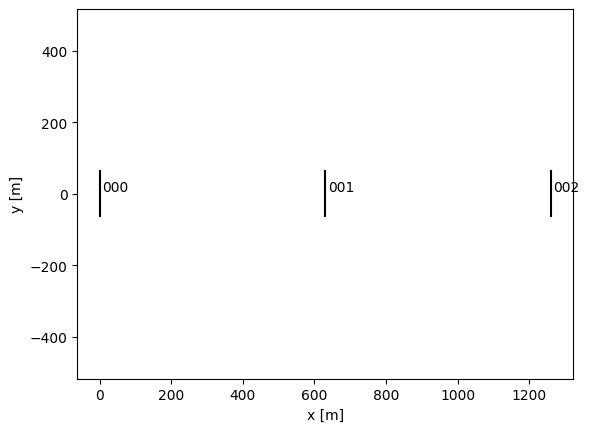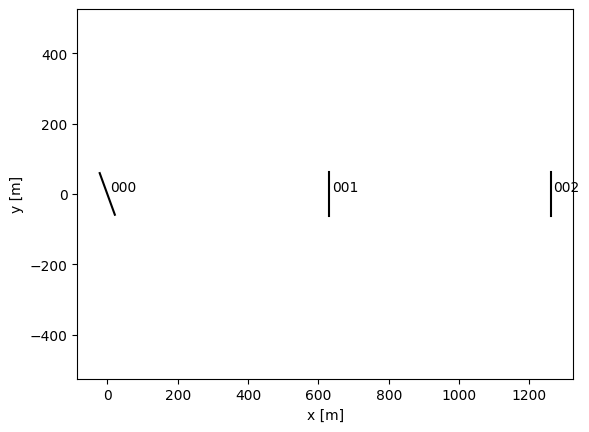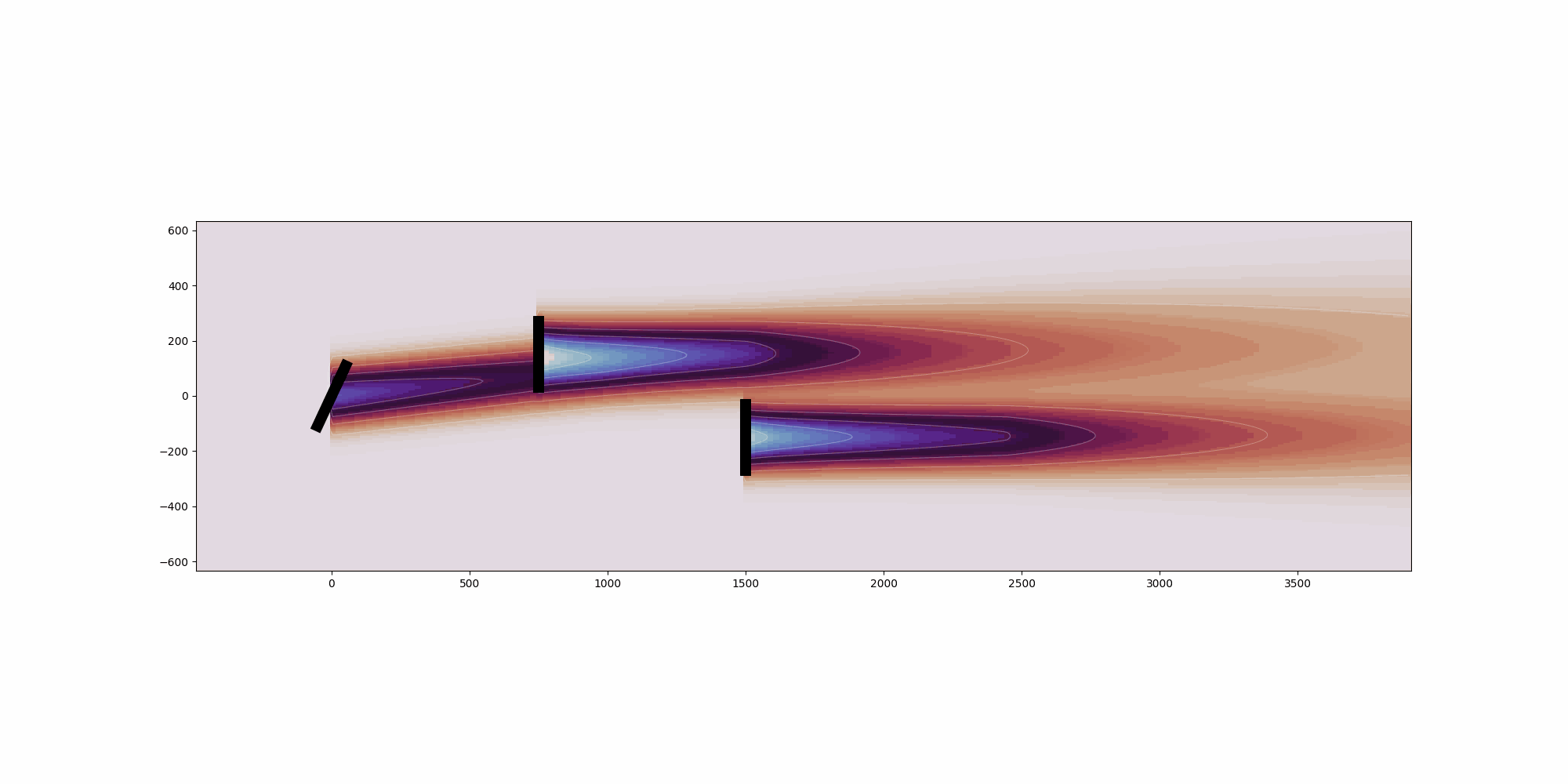Turbine Operation Models#
Separate from the turbine models, which define the physical characterstics of the turbines, FLORIS
allows users to specify how the turbine behaves in terms of producing power and thurst. We refer to
different models for turbine behavior as "operation models". A key feature of operation models is
the ability for users to specify control setpoints at which the operation model will be evaluated.
For instance, some operation models allow users to specify yaw_angles, which alter the power
being produced by the turbine along with it's thrust force on flow.
Operation models are specified by the operation_model key on the turbine yaml file, or by using
the set_operation_model() method on FlorisModel. Each operation model available in FLORIS is
described and demonstrated below. The simplest operation model is the "simple" operation model,
which takes no control setpoints and simply evaluates the power and thrust coefficient curves for
the turbine at the current wind condition. The default operation model is the "cosine-loss"
operation model, which models the loss in power of a turbine under yaw misalignment using a cosine
term with an exponent.
We first provide a quick demonstration of how to switch between different operation models. Then,
each operation model available in FLORIS is described, along with its relevant control setpoints.
We also describe the different parameters that must be specified in the turbine
"power_thrust_table" dictionary in order to use that operation model.
Selecting the operation model#
There are two options for selecting the operation model:
Manually changing the
"operation_model"field of the turbine input yaml (see Turbine Input File Reference)Using
set_operation_model()on an instantiatedFlorisModelobject.
The following code demonstrates the use of the second option.
from floris import FlorisModel
from floris import layout_visualization as layoutviz
fmodel = FlorisModel("../examples/inputs/gch.yaml")
# Look at layout
ax = layoutviz.plot_turbine_rotors(fmodel)
layoutviz.plot_turbine_labels(fmodel, ax=ax)
ax.set_xlabel("x [m]")
ax.set_ylabel("y [m]")
# Set simple operation model
fmodel.set_operation_model("simple")
# Evalaute the model and extract the power output
fmodel.run()
print("simple operation model powers [kW]: ", fmodel.get_turbine_powers() / 1000)
# Set the yaw angles (which the "simple" operation model does not use
# and change the operation model to "cosine-loss"
fmodel.set(yaw_angles=[[20., 0., 0.]])
fmodel.set_operation_model("cosine-loss")
ax = layoutviz.plot_turbine_rotors(fmodel)
layoutviz.plot_turbine_labels(fmodel, ax=ax)
ax.set_xlabel("x [m]")
ax.set_ylabel("y [m]")
# Evaluate again
fmodel.run()
powers_cosine_loss = fmodel.get_turbine_powers()
print("cosine-loss operation model powers [kW]: ", fmodel.get_turbine_powers() / 1000)
simple operation model powers [kW]: [[1753.95445918 436.4427005 506.66815478]]
cosine-loss operation model powers [kW]: [[1561.31837381 778.04338242 651.77709894]]


Operation model library#
Simple model#
User-level name: "simple"
Underlying class: SimpleTurbine
Required data on power_thrust_table:
ref_air_density(scalar)ref_tilt(scalar)wind_speed(list)power(list)thrust_coefficient(list)
The "simple" operation model describes the "normal" function of a wind turbine, as described by
its power curve and thrust coefficient. It does not respond to any control setpoints, and is most
often used as a baseline or for users wanting to evaluate wind farms in nominal operation.
Cosine loss model#
User-level name: "cosine-loss"
Underlying class: CosineLossTurbine
Required data on power_thrust_table:
ref_air_density(scalar)ref_tilt(scalar)wind_speed(list)power(list)thrust_coefficient(list)cosine_loss_exponent_yaw(scalar)cosine_loss_exponent_tilt(scalar)
The "cosine-loss" operation model describes the decrease in power and thrust produced by a
wind turbine as it yaws (or tilts) away from the incoming wind. The thrust is reduced by a factor of
\(\cos \gamma\), where \(\gamma\) is the yaw misalignment angle, while the power is reduced by a factor
of \((\cos\gamma)^{p_P}\), where \(p_P\) is the cosine loss exponent, specified by cosine_loss_exponent_yaw
(or cosine_loss_exponent_tilt for tilt angles). The power and thrust produced by the turbine
thus vary as a function of the turbine's yaw angle, set using the yaw_angles argument to
FlorisModel.set().
from floris import TimeSeries
import numpy as np
import matplotlib.pyplot as plt
# Set up the FlorisModel
fmodel.set_operation_model("cosine-loss")
fmodel.set(layout_x=[0.0], layout_y=[0.0])
fmodel.set(
wind_data=TimeSeries(
wind_speeds=np.ones(100) * 8.0,
wind_directions=np.ones(100) * 270.0,
turbulence_intensities=0.06
)
)
fmodel.reset_operation()
# Sweep the yaw angles
yaw_angles = np.linspace(-25, 25, 100)
fmodel.set(yaw_angles=yaw_angles.reshape(-1,1))
fmodel.run()
powers = fmodel.get_turbine_powers()/1000
fig, ax = plt.subplots()
ax.plot(yaw_angles, powers)
ax.grid()
ax.set_xlabel("Yaw angle [deg]")
ax.set_ylabel("Power [kW]")
Text(0, 0.5, 'Power [kW]')

Simple derating model#
User-level name: "simple-derating"
Underlying class: SimpleDeratingTurbine
Required data on power_thrust_table:
ref_air_density(scalar)ref_tilt(scalar)wind_speed(list)power(list)thrust_coefficient(list)
The "simple-derating" operation model enables users to derate turbines by setting a new power
rating. It does not require any extra parameters on the power_thrust_table, but adescribes the
decrease in power and thrust produced by providing the power_setpoints argument to
FlorisModel.set(). The default power rating for the turbine can be acheived by setting the
appropriate entries of power_setpoints to None.
# Set up the FlorisModel
fmodel.set_operation_model("simple-derating")
fmodel.reset_operation()
wind_speeds = np.linspace(0, 30, 100)
fmodel.set(
wind_data=TimeSeries(
wind_speeds=wind_speeds,
wind_directions=np.ones(100) * 270.0,
turbulence_intensities=0.06
)
)
fig, ax = plt.subplots()
for power_setpoint in [5.0, 4.0, 3.0, 2.0]:
fmodel.set(power_setpoints=np.array([[power_setpoint*1e6]]*100))
fmodel.run()
powers = fmodel.get_turbine_powers()/1000
ax.plot(wind_speeds, powers[:,0], label=f"Power setpoint (MW): {power_setpoint}")
ax.grid()
ax.legend()
ax.set_xlabel("Wind speed [m/s]")
ax.set_ylabel("Power [kW]")
/Users/msinner/floris3/floris/core/turbine/operation_models.py:367: RuntimeWarning: divide by zero encountered in divide
power_fractions = power_setpoints / base_powers
/Users/msinner/floris3/floris/core/wake_deflection/gauss.py:323: RuntimeWarning: invalid value encountered in divide
val = 2 * (avg_v - v_core) / (v_top + v_bottom)
/Users/msinner/floris3/floris/core/wake_deflection/gauss.py:158: RuntimeWarning: invalid value encountered in divide
C0 = 1 - u0 / freestream_velocity
/Users/msinner/floris3/floris/core/wake_velocity/gauss.py:80: RuntimeWarning: invalid value encountered in divide
sigma_z0 = rotor_diameter_i * 0.5 * np.sqrt(uR / (u_initial + u0))
Text(0, 0.5, 'Power [kW]')

Mixed operation model#
User-level name: "mixed"
Underlying class: MixedOperationTurbine
Required data on power_thrust_table:
ref_air_density(scalar)ref_tilt(scalar)wind_speed(list)power(list)thrust_coefficient(list)cosine_loss_exponent_yaw(scalar)cosine_loss_exponent_tilt(scalar)
The "mixed" operation model allows users to specify either yaw_angles (evaluated using the
"cosine-loss" operation model) or power_setpoints (evaluated using the "simple-derating"
operation model). That is, for each turbine, and at each findex, a non-zero yaw angle or a
non-None power setpoint may be specified. However, specifying both a non-zero yaw angle and a
finite power setpoint for the same turbine and at the same findex will produce an error.
fmodel.set_operation_model("mixed")
fmodel.set(layout_x=[0.0, 0.0], layout_y=[0.0, 500.0])
fmodel.reset_operation()
fmodel.set(
wind_data=TimeSeries(
wind_speeds=np.array([10.0]),
wind_directions=np.array([270.0]),
turbulence_intensities=0.06
)
)
fmodel.set(
yaw_angles=np.array([[20.0, 0.0]]),
power_setpoints=np.array([[None, 2e6]])
)
fmodel.run()
print("Powers [kW]: ", fmodel.get_turbine_powers()/1000)
Powers [kW]: [[3063.49046772 2000. ]]
AWC model#
User-level name: "awc"
Underlying class: AWCTurbine
Required data on power_thrust_table:
ref_air_density(scalar)ref_tilt(scalar)wind_speed(list)power(list)thrust_coefficient(list)helix_a(scalar)helix_power_b(scalar)helix_power_c(scalar)helix_thrust_b(scalar)helix_thrust_c(scalar)
The "awc" operation model allows for users to define active wake control strategies. These strategies
use pitch control to actively enhance wake mixing and subsequently decrease wake velocity deficits. As a
result, downstream turbines can increase their power production, with limited power loss for the controlled
upstream turbine. The AWCTurbine class models this power loss at the turbine applying AWC. For each
turbine, the user can define an AWC strategy to implement through the awc_modes array. Note that currently,
only "baseline", i.e., no AWC, and "helix", i.e., the
counterclockwise helix method have been implemented.
The user then defines the exact AWC implementation through setting the variable awc_amplitudes for
each turbine. This variable defines the mean-to-peak amplitude of the sinusoidal AWC pitch excitation,
i.e., for a turbine that under awc_modes = "baseline" has a constant pitch angle of 0 degrees, setting
awc_amplitude = 2 results in a pitch signal varying from -2 to 2 degrees over the desired Strouhal
frequency. This Strouhal frequency is not used as an input here, since it has minimal influence on turbine
power production. Note that setting awc_amplitudes = 0 effectively disables AWC and is therefore the same
as running a turbine at awc_modes = "baseline".
Each example turbine input file floris/turbine_library/*.yaml has its own helix_* parameter data. These
parameters are determined by fitting data from OpenFAST simulations in region II to the following equation:
where \(a\) is "helix_a", \(b\) is "helix_power_b", \(c\) is "helix_power_c", and \(A_\text{AWC}\) is awc_amplitudes.
The thrust coefficient follows the same equation, but with the respective thrust parameters. When AWC is
turned on while \(P_\text{baseline} > P_\text{rated}\), a warning is given as the model is not yet tuned for region III.
The figure below shows the fit between the turbine power and thrust in OpenFAST helix AWC simulations (x) and FLORIS simulations (--) at different region II wind speeds for the NREL 5MW reference turbine.

fmodel.set_operation_model("awc")
fmodel.set(layout_x=[0.0, 0.0], layout_y=[0.0, 500.0])
fmodel.reset_operation()
fmodel.set(
wind_data=TimeSeries(
wind_speeds=np.array([10.0]),
wind_directions=np.array([270.0]),
turbulence_intensities=0.06
)
)
fmodel.set(
awc_modes=np.array(["helix", "baseline"]),
awc_amplitudes=np.array([2.5, 0])
)
fmodel.run()
print("Powers [kW]: ", fmodel.get_turbine_powers()/1000)
---------------------------------------------------------------------------
KeyError Traceback (most recent call last)
Cell In[5], line 1
----> 1 fmodel.set_operation_model("awc")
2 fmodel.set(layout_x=[0.0, 0.0], layout_y=[0.0, 500.0])
3 fmodel.reset_operation()
File ~\projects\floris\floris\floris_model.py:1306, in FlorisModel.set_operation_model(self, operation_model)
1304 turbine_type = self.core.farm.turbine_definitions[0]
1305 turbine_type["operation_model"] = operation_model
-> 1306 self.set(turbine_type=[turbine_type])
File ~\projects\floris\floris\floris_model.py:347, in FlorisModel.set(self, wind_speeds, wind_directions, wind_shear, wind_veer, reference_wind_height, turbulence_intensities, air_density, layout_x, layout_y, turbine_type, turbine_library_path, solver_settings, heterogenous_inflow_config, wind_data, yaw_angles, power_setpoints, disable_turbines)
345 _yaw_angles = self.core.farm.yaw_angles
346 _power_setpoints = self.core.farm.power_setpoints
--> 347 self._reinitialize(
348 wind_speeds=wind_speeds,
349 wind_directions=wind_directions,
350 wind_shear=wind_shear,
351 wind_veer=wind_veer,
352 reference_wind_height=reference_wind_height,
353 turbulence_intensities=turbulence_intensities,
354 air_density=air_density,
355 layout_x=layout_x,
356 layout_y=layout_y,
357 turbine_type=turbine_type,
358 turbine_library_path=turbine_library_path,
359 solver_settings=solver_settings,
360 heterogenous_inflow_config=heterogenous_inflow_config,
361 wind_data=wind_data,
362 )
364 # If the yaw angles or power setpoints are not the default, set them back to the
365 # previous setting
366 if not (_yaw_angles == 0).all():
File ~\projects\floris\floris\floris_model.py:230, in FlorisModel._reinitialize(self, wind_speeds, wind_directions, wind_shear, wind_veer, reference_wind_height, turbulence_intensities, air_density, layout_x, layout_y, turbine_type, turbine_library_path, solver_settings, heterogenous_inflow_config, wind_data)
227 floris_dict["farm"] = farm_dict
229 # Create a new instance of floris and attach to self
--> 230 self.core = Core.from_dict(floris_dict)
File ~\projects\floris\floris\type_dec.py:226, in FromDictMixin.from_dict(cls, data)
221 if undefined:
222 raise AttributeError(
223 f"The class definition for {cls.__name__} "
224 f"is missing the following inputs: {undefined}"
225 )
--> 226 return cls(**kwargs)
File <attrs generated init floris.core.core.Core>:13, in __init__(self, logging, solver, wake, farm, flow_field, name, description, floris_version)
11 _setattr('description', __attr_converter_description(description))
12 _setattr('floris_version', __attr_converter_floris_version(floris_version))
---> 13 self.__attrs_post_init__()
File ~\projects\floris\floris\core\core.py:75, in Core.__attrs_post_init__(self)
69 logging_manager.configure_file_log(
70 self.logging["file"]["enable"],
71 self.logging["file"]["level"],
72 )
74 # Initialize farm quantities that depend on other objects
---> 75 self.farm.construct_turbine_map()
76 self.farm.construct_turbine_thrust_coefficient_functions()
77 self.farm.construct_turbine_axial_induction_functions()
File ~\projects\floris\floris\core\farm.py:262, in Farm.construct_turbine_map(self)
261 def construct_turbine_map(self):
--> 262 self.turbine_map = [Turbine.from_dict(turb) for turb in self.turbine_definitions]
File ~\projects\floris\floris\type_dec.py:226, in FromDictMixin.from_dict(cls, data)
221 if undefined:
222 raise AttributeError(
223 f"The class definition for {cls.__name__} "
224 f"is missing the following inputs: {undefined}"
225 )
--> 226 return cls(**kwargs)
File <attrs generated init floris.core.turbine.turbine.Turbine>:24, in __init__(self, turbine_type, rotor_diameter, hub_height, TSR, power_thrust_table, operation_model, correct_cp_ct_for_tilt, floating_tilt_table, multi_dimensional_cp_ct, power_thrust_data_file, turbine_library_path)
22 __attr_validator_floating_tilt_table(self, __attr_floating_tilt_table, self.floating_tilt_table)
23 __attr_validator_turbine_library_path(self, __attr_turbine_library_path, self.turbine_library_path)
---> 24 self.__attrs_post_init__()
File ~\projects\floris\floris\core\turbine\turbine.py:461, in Turbine.__attrs_post_init__(self)
460 def __attrs_post_init__(self) -> None:
--> 461 self._initialize_power_thrust_functions()
462 self.__post_init__()
File ~\projects\floris\floris\core\turbine\turbine.py:472, in Turbine._initialize_power_thrust_functions(self)
471 def _initialize_power_thrust_functions(self) -> None:
--> 472 turbine_function_model = TURBINE_MODEL_MAP["operation_model"][self.operation_model]
473 self.thrust_coefficient_function = turbine_function_model.thrust_coefficient
474 self.axial_induction_function = turbine_function_model.axial_induction
KeyError: 'awc'
